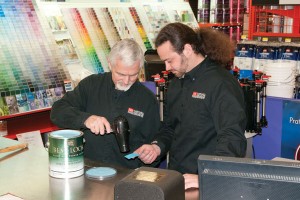To view a PDF of this story, click here.
By Liz Lichtenberger, llichtenberger@nrha.org and Kate Klein, kklein@nrha.org
Your employees are the first contact customers have with your business when they walk in the store. Employees mix paint, repair screens and answer questions, among other tasks. Ultimately, they can be the reason customers visit your store every week—or vow they’ll never shop there again. So, it’s important to find, train and retain employees who will make a positive impact on your business.
Employees, in your customers’ eyes, are your business. They’re as much a part of it as pricing or inventory management. You may own, manage or run the day-to- day operations, but your employees most likely have the greatest amount of interaction with your customers. Since they can make or break a customer’s experience, they should be friendly, knowledgeable and helpful.
This article includes a variety of materials to help you recruit and retain high-quality employees who will provide top-of-the-line customer service, become a wealth of product knowledge and help your business grow and be successful. For this story, we looked at data, spoke with retailers and even sent a Hardware Retailing staffer through training at a local independent home center.
In the following pages, we’ll talk about how to find highly qualified employees and offer tips on how to ensure you retain them and turn them into long-term employees.
Finders
Topics Covered:
- How to find qualified candidates.
- Different ways to conduct interviews.
- What to look for in candidates during interviews.
Finding loyal, well-trained employees starts in the beginning, before new hires accept the jobs, submit
W-4s and learn to cut their first keys. Recruiting high-quality candidates who will serve your store and your customers well starts with the detailed job descriptions you write, how and where job listings are posted and how you prescreen potential candidates. You can’t perfect your hiring process—everyone makes mistakes—but you can improve your candidate pool and then learn how to ask interview questions that help reveal whether a potential employee will be a “keeper” long term.
Starting Out Right
Aimee Nichols used to dread the weeks her store’s job openings came out in local classified ads, because the blitz of phone calls and emails from unqualified candidates was overwhelming.
But she’s been able to improve the advertising, recruiting and interviewing process, and learned to reduce the pool to the best candidates. Doing so has helped her decrease both the number of bad hires and the employee turnover at Berger Hardware in Hawthorne, New York. She co-owns two stores with her brother, Chris Rubeo.
Their goal isn’t to hire the most experienced or qualified-sounding candidates, but to find employees who fit the company culture and will be loyal to the business.
“My brother and I believe we can teach people hardware, but it is difficult to teach someone how to have a positive attitude and work ethic,” Nichols says. “We actually probably hire about 95 percent on personality and the feeling we get when they walk in the door and we talk to them. Having hardware experience is a definite plus, but is no longer the ultimate deciding factor in who we hire.”
Tracie White, who is manager of talent development at HPM Building Supply in Hawaii, also considers personality, willingness to learn and attitude more than work experience. The company operates retail stores, lumberyards and a manufacturing facility, and has business locations on the islands of Hawaii, Oahu and Kauai.
“Of course, it’s wonderful if somebody has knowledge or skill in our industry, but that can be taught,” White says. “We are looking for people who see HPM as their home and customers as their invited guests.”
Finding the Best People
HPM is always recruiting employees—and everyone on HPM’s payroll is on the lookout for new talent. All employees are encouraged to pass out business cards to people they meet who they think would fit in well at the company. Employees who aren’t in management can hand out generic business cards with the store’s contact information on them.
White recently gave her card to a server at a cafe where she stopped to get coffee with her children. She asked the server to apply at HPM if she was interested in changing jobs.
“She was smiling, had a great attitude, was sparkling,” White says. “This is being proactive and going out and finding great people ahead of the game and matching them with a position as it becomes open.”
Recruiting via word of mouth, though, doesn’t work for every position every time.
Both HPM and Berger Hardware use the employment search engine Indeed.com to post job listings with descriptions of the candidate characteristics they’re looking for. HPM also accepts applications through its website.
For recruiting, Ace Hardware Home Centers, Inc., relies heavily on snagajob.com, a website that posts openings for hourly jobs on multiple online jobs boards.
The company, which has four stores in Colorado and two stores in Wyoming, also lists job openings on Craigslist and Facebook.
Facebook can work well for recruiting because applicants who find the company’s social media job postings often are already customers, like the business and live nearby, says Beth Patrick, director of human resources and risk management for the small chain.
“We keep job postings going pretty much all the time,” she says. “I’m always looking for a great candidate. If a great candidate comes across, I’m going to hire them whether I have an open position or not.”
Indeed.com allows Nichols to post detailed job descriptions and specifics on what she’s looking for in a candidate, including years of experience.
To improve her recruiting and hiring process, she developed accurate job descriptions for roles throughout the business so the online ads could be more specific about expectations for the positions.
The quality of job applicants for positions at Berger Hardware has shot up, and the website makes screening potential hires easier.
Nichols can delete applications and resumes quickly based on criteria such as the person’s address in a distant town or gaps in employment history.
The goal is to land a qualified, committed worker from the start and cut back on the time spent trying to fill jobs and train employees who don’t turn out to be good fits long term.
Interviewing, hiring and training people who don’t stay with the business very long decreases operational efficiency and causes distractions, Nichols says.
“I can’t express the dollar value of a person who is reliable,” she says.
Word-of-mouth referrals have always been important for hiring and recruiting employees, and getting suggestions from people Nichols knows is still a solid way to find high-quality candidates, she says.
But Indeed.com has become a reliable resource, so she has been able to cut back on classified advertising. “Indeed definitely narrowed the field for us,” Nichols says.
The Interview Process
Including multiple staff members in the interview process has also improved the way Berger Hardware and HPM vet high- quality employees.
Job applicants typically interview on the phone with a human resources representative at HPM, and then with a store manager or direct supervisor. The two HPM staffers then discuss whether to hire the candidate.

“The first interview is really on our corporate culture and how the candidate would fit into the HPM corporate culture. We’re looking more for attitude,” White says. “We do the collaborative process of HR and the direct manager so it’s a team effort in hiring the right person.”
Hiring is something of a group effort at Ace Hardware Home Centers. Patrick trains her managers to oversee group interviews with four or five candidates so they can see how prospective employees interact. The interviewer gets to meet the candidates, but also watch the potential hires meet each other.
“I love the dynamics of a group interview,” Patrick says.
A group interview is the step following phone interviews at Ace Hardware Home Centers. The managers hosting the group interviews are trained to ask behavioral questions to learn, for example, how the potential employees interacted with difficult customers in past retail jobs.
“You’re really watching for the nonverbal cues, too. Are they polite? Are they smiling?” she says.
The manager also asks the prospects to head to the salesfloor to find products they have never used before, and then return to explain the items based on what they learned from the labels.

Potential hires can really set themselves apart during that phase of the interview by confidently explaining products just based on what the labels say, Patrick says.
White asks interview questions that bring out character traits to see how teachable job candidates might be and what their personalities are like.
Her questions include, “Can you describe a recent unpopular decision that you made and what the result was?” and “Describe a project implemented because of your efforts. What was your role and what was your outcome?”
At Berger Hardware, Nichols includes department heads in her hiring process. She asks those employees to help her sort through applications and join in the interviewing.
Recently, Nichols also gave two potential hires the opportunity to work for a day at the store to help her decide whether to hire them.
“I just thought in my head, ‘I wish I could see this guy working,’” she says.
She hired one of the job candidates, and came to a mutual agreement with the other that he was a bad fit for the business.
The experience was positive for both Nichols and for the candidate she didn’t hire because the day in the store helped them agree Berger Hardware wasn’t the place for him.
“It worked out well. It potentially saved us from making a not-great hire. It kept him from committing to us and working here a month and then leaving,” she says.
Keepers
Topics Covered:
- Benefits, including both cash rewards and non-financial incentives.
- The importance of reviews and regular conversations with your employees.
- How to have the difficult conversations.
You’ve worked hard to hire a good team and get everyone trained. You’ve invested time and money in them—according to North American Retail Hardware Association (NRHA) estimates, it costs more than $6,000 to hire and train a new employee—and you want to make sure they are happy in their jobs and are ultimately working to make your business more successful. So what do you do to make sure those employees aren’t looking for jobs elsewhere?
Unique Benefits
Of course, money is important. However, when an employee considers his job satisfaction, he’s thinking about more than the amount of money he takes home every two weeks.
Unique benefits, a positive work environment and more can be the difference between a good employee staying long-term or turning in his two weeks’ notice.
“I think, in general, most of our incentives are to obviously make our current employees feel appreciated and celebrate their achievements,” White says. “We are 100-percent employee- owned. We are one of the first companies in Hawaii to have an employee stock program.
Within a year of working at HPM, [an employee] becomes an owner. They are vested after five years. ESOP is at no cost to them and really changes everybody’s mindset.”
If employees feel like they’re part of the bigger picture, they’re more likely to work a little harder and give extra effort—and sometimes that little extra effort can take an employee from good to great.
Nearly 93 percent of respondents to NRHA’s 2014 Employee Compensation Study say they offer in-store discounts, and nearly 70 percent offer salary bonuses.
But fewer offered less traditional benefits, such as a company car (22 percent), a laptop or tablet (17 percent), tuition reimbursement (16 percent) or parental leave (16 percent). Offering these nontraditional benefits can help you keep good employees around.
More than three-quarters of the study respondents provide an employer match to a retirement plan, with the majority (63 percent) matching up to 3 percent.
There are ways to do something different with those more common benefits, too, and switching things up can help keep employees happy. They will also motivate employees to work harder, which means increases to your bottom line.
For example, let’s look at salary bonuses. Many, if not most, bonuses are given yearly. If the bonuses were handed out more frequently, the incentives could be more top-of-mind for employees, and inspire employees to work a little harder to earn them.
Consider giving out bonuses quarterly instead. Doing so may be a little more work for you, but could motivate employees as they strive to reach a sales goal and earn that extra money.
At HPM, employees are rewarded with cash or gift cards if they’re a top performer in the store’s regular mystery shops and the results of customer phone surveys that allow customers to give feedback on their experiences at the stores.
Of course, it’s important to consider non- financial rewards, as well.
For example, instead of a bonus, consider offering an extra day of paid time off to employees to recognize them for a job well done. Benefits, both financial and non-financial, all tie in with the culture you have created for your company, and a positive culture is what employees want.
Good Communication
It’s important to provide open communication from the very beginning of an employee’s time working at your business. You should have clearly written job descriptions for each position in your store.
This is especially important in a small business, where employees often wear several different hats.
Lack of clarity about expectations and lack of feedback keeps employees from reaching their full potential.

Also, even though you’re the boss, it’s important that you let employees have a say.
Let them try something they’ve suggested, even if you are skeptical. Maybe it will—and if it doesn’t, they’ll have learned the lesson better than if you just told them “no,” and they’ll appreciate an opportunity to have their ideas heard and tried.
At HPM, employees can share their ideas via an app that sends them questions twice a month asking about their experience at the company, including questions such as “Do you have all the tools you need to be successful in your role?” and “How do you like the company culture?” All responses are anonymous.
“It gives us really honest feedback on how we’re doing as a company,” White says. “Our leadership team replies to almost everybody’s feedback. We get a lot of amazing suggestions for improvement.”
The app also includes a section called Cheers for Peers, where employees can applaud their co-workers on jobs well done.
“It’s always good for your morale to be recognized by your peers,” White says.
The executive team recognizes those who have received and those who have given the most cheers, as well as workers who have reached a milestone anniversary or have provided excellent customer service during mystery shops and phone calls.
Of course, there are times when co-workers may have less positive things to say, but White encourages them to remind each other of various ways they can improve.
“It’s very common for teammates to coach each other on service, offering specifics on improvement,” she says.
Another way to encourage open communication is to get your employees involved in the hiring process. Nichols includes employees who oversee store departments in her hiring decisions. For example, her head cashier reviews applications and participates in interviewing potential cashiers.
The department heads are more satisfied with the hiring process and committed to training the new employees because they help make the hiring decisions, Nichols says.
“They’re committed to that person because it’s their choice,” she says. “It’s just different. It’s not, ‘Oh, who did Aimee hire this time?’”
Make sure to provide open communication in other ways, as well.
If an employee does something incorrectly, let them know so they can correct it and know how to better themselves for the next time a similar situation arises. Conversely, if they do something great, make sure to let them know that, too.
Effective Employee Reviews
Consider doing your employee reviews more frequently.
The annual review can cover raises or bonuses, but a midyear or quarterly review can help employees get more frequent feedback.
You are busy and while you intend to chat more frequently with your employees about how they’re doing at work, all too often the only time there’s talk outside of a formal review is when there’s a problem. Setting up more frequent reviews could change that.

Patrick says new employees receive two- month, six-month and one-year reviews. After the first year, reviews are done annually.
“If they receive a promotion into a different position, they’ll do two-month, six-month and one-year reviews again,” she says.
“I think it works very well. High-performing associates and managers want to know how they’re doing and how they can do better.”
Each review is a little different; for example, the two-month review includes a checklist of tasks to learn, and the employee and manager talk about which of these items the employee has done and which have not been done.
The six-month and one-year reviews use a grading system, but there’s plenty of room for additional notes.
“People really thrive on the comments and the feedback,” Patrick says.
Starting this year, reviews at HPM will be done more often, and they’ll be more conversational, White says.
“In the past, reviews could be very subjective,” she says. “This new system will involve coaching on a more regular basis.”
In the past, they’ve been done in a traditional manner, but the new format will involve a more collaborative coaching system between the supervisor and owner-employee.
“We’ll continue to set smart, specific, attainable goals,” she says. “We want reviews to be more of a mutual conversation and agreement between the supervisor and employee.”
While it’s important to fill out an employee evaluation form, don’t rely on the document for the only discussion topics in a meeting.
Use the form as an outline, but don’t read directly from it—employees can review it on their own. Instead, use it to highlight some points, both positive and negative, that you’d like to make. Use the evaluation as a conversation starter.
It’s a good idea to have employees fill out their own version of the form, too, before the review, and then the two of you can compare your notes. Areas where your thoughts differ are the areas that will likely need further discussion.
(Visit TheRedT.com/1HWLfYc for a printable form you can use for your employee reviews. Additional evaluation sheets and other forms are available for NRHA members in the Human Resources Handbook at nrha.org.)
Of course, formal evaluation forms aren’t needed at all meetings.
Consider holding midyear or quarterly reviews as short chats—just a chance for you and your employee to catch up informally.
Use the brief conversations to let workers know how you think they’re doing, and make sure to discuss with them any of their comments, questions or concerns.
(Of course, if you do have any serious concerns about their job performance, you should have those in writing and be ready to address them—and don’t wait until the next scheduled review.)
Also take some time to discuss goals with your employees. Think about how those goals can be reviewed at meetings that are held quarterly or twice a year. Longer-term goals can be discussed at annual reviews.
Many businesses do exit interviews with employees who have chosen to leave, but why not occasionally conduct similar interviews with your current employees?
The Hard Conversations
While many employee reviews can be overwhelmingly positive, there are those times you’ll need to have a difficult conversation with an employee that may result in disciplinary action.

“I sit down with an associate or manager and have a conversation about what happened before I jump into corrective action,” Patrick says.
It’s important to talk and find out everyone’s side of the story. Often, the issue arises from a simple lack of understanding or miscommunication.
“It could be that they were simply acting in the way they were trained,” Patrick says. “So many times, employees inherently believe they acted in the right away.”
Unfortunately, there come times when those conversations may include, or lead to, disciplinary action. Here are a few tips for making those types of conversations a little bit easier for everyone:
- Document everything. Put everything in writing: what offense the employee committed, more details about what happened, how frequently it happened, any prior discussions or warnings that may have taken place or been issued and any other pertinent information.
- Make a plan. It’s best to have a plan of action ready to go. This can be anything from a written warning to termination, depending on the severity and frequency of the offense.
- Take notes. Make notes during the meeting and have the employee sign off, acknowledging that the issue was discussed and the consequence was agreed upon. Make copies of the notes and signatures and give one copy to the employee. Put the other in his or her file. If the employee has a company email address, it doesn’t hurt to follow up that meeting with an email detailing the notes.
- Follow up. Check in with the employee at agreed-upon intervals to ensure the issue is being resolved and both you and the employee are following the agreed-upon courses of action to fix it.
Now that you know how to recruit and retain quality employees, it’s time to talk about another important step: training.
Whether you’re looking for quick ways to teach employees about of add-on selling skills and strong product knowledge or want a step-by-step guide to setting up a comprehensive training program, NRHA can help. We’ve also compiled information about job descriptions, personality tests and more.
New Training Resources
Train the Trainer
This downloadable PDF booklet is a quick-start guide as well as an ongoing reference for the trainer.
Topics include the importance of training, a step-by-step outline of how to set up a training program, tips on maintaining a successful training program and how to use the training courses NRHA has to offer.
How to get it: Download the PDF at nrha.org/FreeTraining.
Trainer’s Toolbox
The Trainer’s Toolbox series is offered to retailers as an ongoing training resource for employees. The quick lessons include short videos, worksheets or PowerPoints with quick tutorials or quizzes about a certain aspect of the business.
Each covers one of four categories—merchandising, selling skills, product knowledge or operations—and comes with a “Trainer’s Notes” page that offers a brief explanation of the lesson and some suggestions for how the trainer can use it with his or her employees.
How to get it: Four lessons will be published on the first Monday of each month at nrha.org. The first four will include lessons on:
- Making a Good First Impression on Customers
- Add-on Sales
- Working With Difficult Customers
- How to Build a Great Endcap
Download them at nrha.org/FreeTraining.
Other Resources
We’ve also gathered a variety of resources, and we’ve posted them in one place on our website for your convenience.
Go to theRedT.com/1Qhk0Kz to learn more about the following:
- How to write clear, comprehensive job descriptions for various positions.
- What millennials are looking for in a job.
- Other prescreening tools, such as personality tests, that can help ensure you’re finding employees who will be a good fit for your business and its culture.
Employee Experience
Hardware Retailing staffer Graeme Haase went behind the scenes at Cardwell Do it Best Home Center in Indianapolis, where he participated in an accelerated training program over the course of three days so he could see firsthand what a new sales associate’s training is like and share his experiences and impressions with retailers.
 Hardware Retailing The Industry's Source for Insights and Information
Hardware Retailing The Industry's Source for Insights and Information










